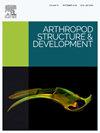Structure and variability in the female genital atrium of Uropodina (Acari: Parasitiformes)
IF 1.3
3区 农林科学
Q2 ENTOMOLOGY
引用次数: 0
Abstract
Primary and secondary sexual characters of Mesostigmata are often used in species descriptions and phylogenetic analyses. The use of these characters has been focused almost exclusively on external structures. Digital 3D reconstruction based on synchrotron X-ray microtomography (SR-μCT) data allowed a comparative investigation of the structure of an internal system, the female genital atrium, in the mite lineage Uropodina (Parasitiformes: Mesostigmata). Despite substantial variability in observed structures, a general model for the endogynium, vagina, and muscle structure has been generated using a combination of SR-μCT and light microscopy. Most of the variations are hypothesized as related to species recognition and/or manipulation of the endospermatophore. The recorded variability may have substantial phylogenetic value, as a previously unreported modification of the vagina appears to diagnose a substantial lineage of “higher” Uropodina. This set of observations also support the hypothesis that the large family Urodinychidae is polyphyletic. Overall, SR-μCT and 3D reconstruction turned out to be very helpful for studies on internal organ systems in these very small organisms, lessening the need for laborious dissections or extensive Transmission electron microscopy-based investigations.
尾足螨(蜱螨目:寄生目)雌性生殖心房的结构和变异
中柱头属植物的主要和次要性别特征常用于物种描述和系统发育分析。这些字符的使用几乎完全集中在外部结构上。基于同步加速器x射线微断层扫描(SR-μCT)数据的数字三维重建,对尾足螨(寄生目:mesostimata)螨系内部系统——雌性生殖心房的结构进行了比较研究。尽管观察到的结构有很大的差异,但利用SR-μCT和光学显微镜的结合,已经产生了一个关于阴道内腔、阴道和肌肉结构的一般模型。大多数变异被假设为与物种识别和/或胚乳包的操作有关。记录的变异可能具有重要的系统发育价值,因为以前未报道的阴道修饰似乎可以诊断出“高级”尾足动物的实质性谱系。这组观察结果也支持了一个假设,即大的Urodinychidae家族是多种的。总的来说,SR-μCT和3D重建被证明对这些非常小的生物的内部器官系统的研究非常有帮助,减少了费力的解剖或广泛的透射电子显微镜研究的需要。
本文章由计算机程序翻译,如有差异,请以英文原文为准。
求助全文
约1分钟内获得全文
求助全文
来源期刊
CiteScore
3.50
自引率
10.00%
发文量
54
审稿时长
60 days
期刊介绍:
Arthropod Structure & Development is a Journal of Arthropod Structural Biology, Development, and Functional Morphology; it considers manuscripts that deal with micro- and neuroanatomy, development, biomechanics, organogenesis in particular under comparative and evolutionary aspects but not merely taxonomic papers. The aim of the journal is to publish papers in the areas of functional and comparative anatomy and development, with an emphasis on the role of cellular organization in organ function. The journal will also publish papers on organogenisis, embryonic and postembryonic development, and organ or tissue regeneration and repair. Manuscripts dealing with comparative and evolutionary aspects of microanatomy and development are encouraged.

 求助内容:
求助内容: 应助结果提醒方式:
应助结果提醒方式:


